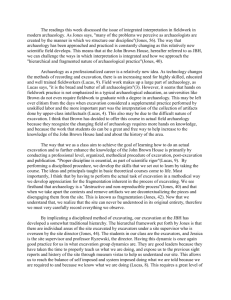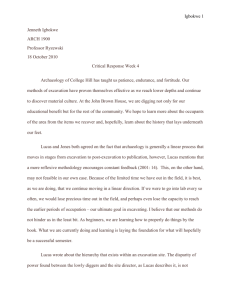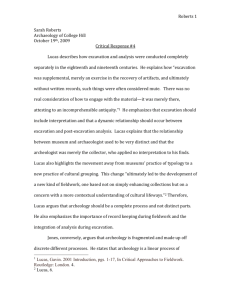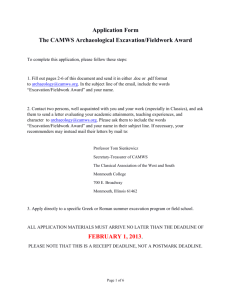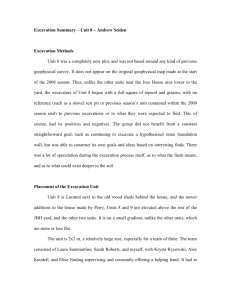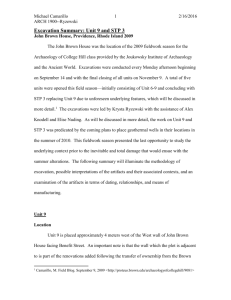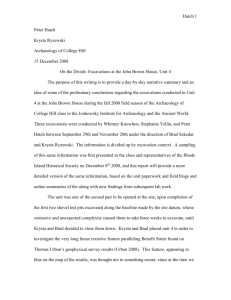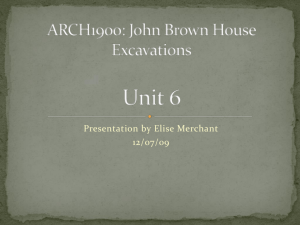Nick Bartos Critical Response 1
advertisement
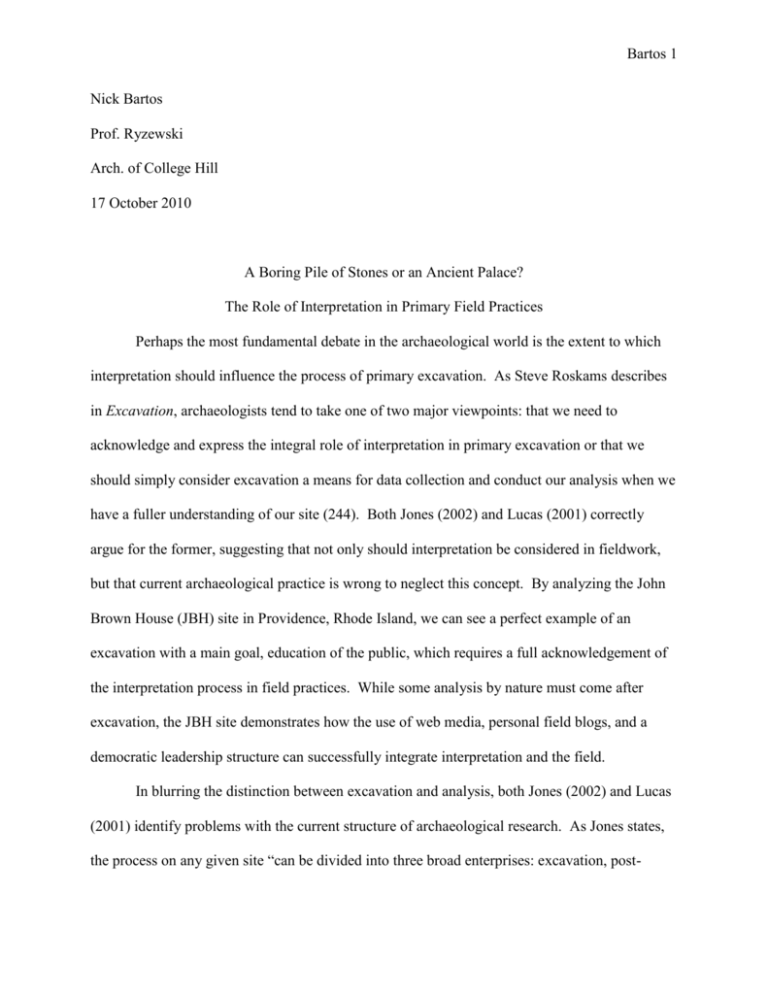
Bartos 1 Nick Bartos Prof. Ryzewski Arch. of College Hill 17 October 2010 A Boring Pile of Stones or an Ancient Palace? The Role of Interpretation in Primary Field Practices Perhaps the most fundamental debate in the archaeological world is the extent to which interpretation should influence the process of primary excavation. As Steve Roskams describes in Excavation, archaeologists tend to take one of two major viewpoints: that we need to acknowledge and express the integral role of interpretation in primary excavation or that we should simply consider excavation a means for data collection and conduct our analysis when we have a fuller understanding of our site (244). Both Jones (2002) and Lucas (2001) correctly argue for the former, suggesting that not only should interpretation be considered in fieldwork, but that current archaeological practice is wrong to neglect this concept. By analyzing the John Brown House (JBH) site in Providence, Rhode Island, we can see a perfect example of an excavation with a main goal, education of the public, which requires a full acknowledgement of the interpretation process in field practices. While some analysis by nature must come after excavation, the JBH site demonstrates how the use of web media, personal field blogs, and a democratic leadership structure can successfully integrate interpretation and the field. In blurring the distinction between excavation and analysis, both Jones (2002) and Lucas (2001) identify problems with the current structure of archaeological research. As Jones states, the process on any given site “can be divided into three broad enterprises: excavation, post- Bartos 2 excavation, and publication” (2002: 39). Jones’ main complaint is that in this division, the archaeological record effectively becomes fragmented as “the objects from the site and the scientific analysis of those objects are gradually pulled further apart” (2002: 42). In essence, archaeologists decontextualize a site by reducing its physicality to nothing but bags of artifacts, handing those artifacts to specialists who were not involved in the excavation, and finally publishing a report written primarily by the site-director, the person most distanced from the actual digging. Lucas attributes fragmentation to an earlier “division between the fieldworker and the intellectual elite,” a time when great archaeologists never visited a site (2001: 5). Excavation was the basis of raw data rather than “the observation of material in situ” (2001: 5). Furthermore, both Jones (2002) and Lucas (2001) describe the archaeological hierarchy: the levels of distance between excavators, supervisors, and the actual people who analyze finds. Overall, the authors effectively highlight major flaws in current archaeological practice that mask initial interpretation in excavation. The John Brown House site serves as a great example of why primary excavation interpretations must be acknowledged and made accessible to the public. However, before describing how the JBH site overcomes many of Jones’ (2002) and Lucas’ (2001) concerns, we must first understand the major purposes of the JBH excavation. The majority of work at the JBH is completed by a small group of Brown University students in conjunction with the Rhode Island Historical Society and the John Brown House Museum. Thus, the site is not only important for unraveling the past, but it is also used as an educational tool about archaeological practices in general. Also, while analysis at the JBH might indicate greater cultural trends, the majority of research is localized and focused only on the actual house area. The aim is not to solve some grand multi-regional mystery, but rather to give an accurate outline of events in a Bartos 3 given community. Therefore, the fundamental purpose of the JBH site is public education, both of the history of Providence and archaeological methods as a whole. Because the main thrust of the JBH excavation is public education, the site verifies Jones’ (2002) and Lucas’ (2001) claim that interpretation is integral to excavation. For example, if we want to use the JBH site to educate the public on the archaeological process in general, we need to expose the rational and interpretation of every step in excavation rather than just presenting a final publication. Furthermore, if we are to engage in a true historical dialogue, we must express all available details and analyses, even if they do not fit into a concise model. Luckily, the JBH project already incorporates many outlets for these types of discussions. Online field blogs allow excavators to describe and interpret each day in the field. Unit summaries complete with updated pictures are compiled each week and are important in tying multiple areas of the JBH site together. In addition, the JBH project largely dissolves Jones’ (2002) “hierarchy” as excavators not only decide where to place units, but they are also chiefly in charge of analyzing artifacts and writing the final site publication. Thus, the JBH project manages to integrate interpretation and excavation, and in doing so, proves that this unification in archaeology is vital, and in this case, necessary for the purpose of the project. Through an analysis of the John Brown House excavation, we can verify the arguments made by both Jones (2002) and Lucas (2001). It is obvious that the use of field blogs and evolving unit summaries, as well as the lack of a structure hierarchy are positive steps towards achieving the greater goals of the JBH project. However, if we consider the JBH a success, we must ask an important question: can we translate the JBH methods to a much larger, more complicated site? Certainly, with such a site there would have to be some form of fragmentation or hierarchy, lest there be no real division of the workload and no true organization. Still, while Bartos 4 we may conclude that the JBH site successfully integrates interpretation and excavation only because of its size, we can never know for sure unless we take the same approach to a larger site. Therefore, as always, we reach our most common archaeological conclusion: that we simply must continue digging. Bartos 5 Works Cited Jones, Andrew. 2002. "Archaeology Observed." Archaeology Theory and Scientific Practice. Cambridge: Cambridge University Press. 39-62. Lucas, Gavin. 2001. "Archaeology and the Field." Introduction. Critical Approaches to Fieldwork. London: Routledge. 1-17. Roskams, Steve. Excavation. Cambridge: Cambridge University Press, 2001. Print.
